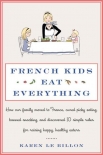French Kids Eat Everything Karen Billon (romance novel chinese novels txt) 📖

- Author: Karen Billon
Book online «French Kids Eat Everything Karen Billon (romance novel chinese novels txt) 📖». Author Karen Billon
The lost cupcake wasn’t the only example of wasteful eating that we encountered. The school didn’t have a cafeteria, but it had organized “hot lunches” three days per week. Children were given the option of pizza on Mondays, Subway sandwiches on Wednesdays, and sushi on Fridays. Drinks and food came in individual packaging, necessary because each child got to choose their own toppings (but they got only one choice, which they had to eat every week for four months). We couldn’t believe the sheer volume of waste that was generated, particularly given the contrast with France, where everything had been reusable—napkins, tablecloths, cutlery, plates, cups, even the breadbaskets on the tables. This was a side benefit of the French approach that we hadn’t thought of: in addition to requiring children to taste a wide variety of dishes and foods, the French approach to eating was much more environmentally friendly.
As the year went on, Sophie grew increasingly sensitive about our attitudes toward the food at school. But we—and Philippe, in particular—didn’t hesitate to let her know what we thought. One afternoon, she came home smiling and waving a permission slip. Her class had raised the most money in the school walk-a-thon, and the reward was … a trip to McDonald’s. Grumbling, Philippe signed the form, but crossed out the “Happy” in “Happy Meal,” scrawling Happy but not Healthy across the form in large indignant letters.
Claire, meanwhile, was rediscovering the pleasures of snacking. She tucked into the morning and afternoon snacks (up to three servings!) at her new day care with obvious delight. Soon, she began refusing to eat breakfast, passing up my lovingly prepared oatmeal and fresh fruit because she knew that she could eat the early morning snack that would be waiting upon her arrival at day care. And large snacks were often served at 5:00 P.M., right before we picked her up. Claire would fill up and then toy with her food at dinner. I was frustrated, to say the least. But I realized that I wasn’t the only one who felt this way after I tried mentioning snacking to a few other parents. So at our next parents’ meeting, we politely proposed a solution: only fresh fruit was to be served at afternoon snack, and no snacking after 4:00 P.M. The day care staff was happy to oblige. A large, attractive basket was placed at the entrance next to the sign-in sheet, and parents were encouraged to bring “fresh fruit to share.” Claire proudly brought in strawberries, cantaloupe, and even a watermelon.
Lunch was a more difficult challenge. The staff started cooking one hot lunch for children every month. And parents began returning the favor and making meals for the staff (my favorite contribution is homemade apple-rhubarb crumble). But apart from that one day a month, Claire’s lunch often came home unfinished. Health regulations (predicated on a fear of food poisoning) prevented staff at our day care from heating up the food brought from home. Hot food could be sent in a thermos, but it would sit for hours before being served—hardly an appetizing option. We were reduced to cold foods, but our choices were limited as the girls weren’t used to eating cold foods at lunchtime. They didn’t like sandwiches (Claire still won’t eat them). And I didn’t want to serve them what the other kids seemed to be getting: juice, crackers, and fruit were popular, but hardly a substantial lunch.
Was I the only parent that felt this way? I started striking up casual conversations with other parents at drop-off and pick-up. But I did so warily. The topic of family food choices, as I found out, is very sensitive. In a culture that associates food with guilt rather than pleasure and focuses on the consequences rather than the experience of eating, people are very ready to take offense. I didn’t want anyone to think that I was passing judgment.
My first allies were moms from places like Iran, Italy, China, Brazil, and Spain. They also had traditional food cultures in which lunch was an important meal. From chatting with them, I realized that I wasn’t the only parent who despaired at my kids filling up on snacks, eating little at breakfast and less at lunch. In fact, nearly every parent I spoke to who was not from North America felt the same way. We compared notes and found that our kids were having three snacks a day: morning, afternoon, and at pick-up. And most of our kids’ food consumption (at least in terms of calories) happened at snacktime rather than mealtime.
Was this the case for most kids? I wondered. How could we find out? I didn’t relish the thought of hovering outside the day care, canvassing busy parents as they hurried past. But I didn’t want to jump to conclusions before going to the day-care manager and suggesting changes to how the children were fed.
Would it be impossible to serve hot meals to the kids, like the French do? I wondered. Each day care (there were over a dozen side by side) had a fully outfitted kitchen, complete with stove and oven. But it was little used—mostly for reheating staff meals or making light snacks such as muffins. Would it be possible to start a hot lunch program if enough parents were interested?
“Why don’t you do a survey?” suggested Philippe one evening. “It wouldn’t be hard to do. There are even free survey websites on line. And that way you’d have more evidence that other parents actually like your idea.”
Daunted, but intrigued, I spent the next few weeks drafting questions





Comments (0)